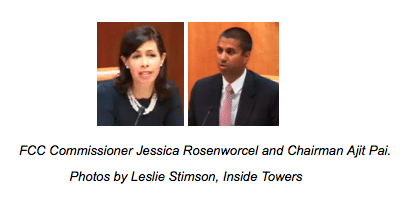
Three people working on the WSVN television transmission tower have died after the ginpole they were on collapsed in Miami Gardens, FL late Wednesday afternoon according to WSVN, the station that housed the tower. Miami-Dade Fire Rescue responded to the scene at 501 NW 207 Street in Miami Gardens, at around 4 p.m.
The ginpole gave way, according to witnesses, killing three crew members hired by WSVN to work on the tower, which is shared with WPLG, WSVN reported. According to Miami-Dade Fire Rescue, the crew fell about 300 to 400 feet. WSVN said they had hired Tower King II out of Texas to do work on the tower. Continue Reading



 A
battle is being waged over whether the FCC should foster access to
spectrum for a variety of network solutions, or primarily for the
current, large mobile carriers in the Citizens Broadband Radio Service.
The FCC in 2016 opened up the CBRS band for both licensed and unlicensed
sharing with U.S. Navy radar operations at 3.5 GHz and satellite earth
stations. The FCC wants to make licensed spectrum affordable to deliver
high quality broadband internet, cellular offload and capacity
densification, and similar connectivity services, like the Internet of
Things. Priority Access Licenses (PALs) cover small areas and are re-auctioned after relatively short (three or six-year) terms.
A
battle is being waged over whether the FCC should foster access to
spectrum for a variety of network solutions, or primarily for the
current, large mobile carriers in the Citizens Broadband Radio Service.
The FCC in 2016 opened up the CBRS band for both licensed and unlicensed
sharing with U.S. Navy radar operations at 3.5 GHz and satellite earth
stations. The FCC wants to make licensed spectrum affordable to deliver
high quality broadband internet, cellular offload and capacity
densification, and similar connectivity services, like the Internet of
Things. Priority Access Licenses (PALs) cover small areas and are re-auctioned after relatively short (three or six-year) terms.



 CTIA-the
Wireless Association and T-Mobile have weighed in on the FCC’s proposal
to add a Blue Alert code to Wireless Emergency Alerts (WEA) and the
broadcast Emergency Alert System (EAS). Blue Alerts, meant to signal a
police officer is in danger, can be transmitted to cell phones and
wireless devices, broadcast stations, overhead highway message signs,
and other secondary alerting mechanisms – in the same way Amber Alerts
are issued.
CTIA-the
Wireless Association and T-Mobile have weighed in on the FCC’s proposal
to add a Blue Alert code to Wireless Emergency Alerts (WEA) and the
broadcast Emergency Alert System (EAS). Blue Alerts, meant to signal a
police officer is in danger, can be transmitted to cell phones and
wireless devices, broadcast stations, overhead highway message signs,
and other secondary alerting mechanisms – in the same way Amber Alerts
are issued.